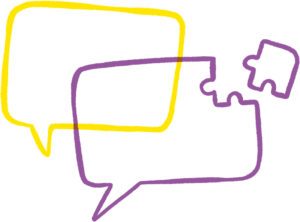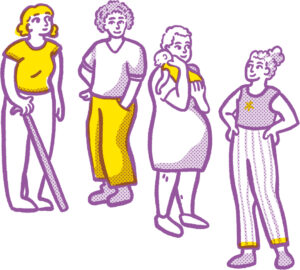Guidelines for a more inclusive language
You want to use more inclusive language and don‘t know exactly how?
You want to avoid discriminatory language for more inclusive language and acknowledge that there are more than two sexes and genders?
You want to use language that breaks down barriers instead of reinforcing them and to tap into the potential of a multilingual society?
Then our recommendations will provide some answers!
In general, we recommend EITHER using language that omits sexgender(1) OR language that makes sexgender diversity visible. Feminist linguistics refer to the former as „gender-indifferent“ language (see Kargl et al 1997). Sometimes it is also called „gender-neutral“ language. This kind of language allows a text to focus on relevant statements, task areas, and content. Language that makes sexgender diversity visible is important when sexgender is central to the statement. In queer linguistics this is known as „sexgender-marking“ or „sexgender-diverse“ language (Baumgartinger 2023).
The category of sexgender does not stand alone but is interwoven with other social categories and attributions such as migration experience, race, ethnicity, disability, class, religion, and many more Therefore, an important part of amore inclusive, sexgender-just language is to refrain fromstereotypical statements and metaphors It is importantto avoid a one-dimensional image of people and to thinkabout diversity, difference and different forms of discriminationfrom the very beginning – in text, images, words and gestures.
![]() NOTE: For an overview of appropriate alternatives to problematic terms and phrases related to these identity markers see for instance the APA (American Psychological Association) “Inclusive Language Guidelines”: www.apa.org/about/apa/equity-diversity-inclusion/language-guidelines
NOTE: For an overview of appropriate alternatives to problematic terms and phrases related to these identity markers see for instance the APA (American Psychological Association) “Inclusive Language Guidelines”: www.apa.org/about/apa/equity-diversity-inclusion/language-guidelines
In addition to respectful communication, another goal of inclusive language is to be as accessible as possible. The first step is to use simple, easy to read language and to properly introduce technical terms. Furthermore, multilingualism is an important part of our everyday social life. For an inclusive language it is important to take multilingualism into account and to use respective non-discriminatory language.
![]() NOTE: Detailed information on accessibility and multilingualism in the context of inclusive language can befound in 03 „Sprache & Diversität in der Lehrpraxis”
NOTE: Detailed information on accessibility and multilingualism in the context of inclusive language can befound in 03 „Sprache & Diversität in der Lehrpraxis”

Inclusive Language in written and oral communication
(based on and adapted from the United-Nations “Guidelinesfor Gender-Inclusive Language in English” with some additions)
English is a gender-neutral language and has very few gendermarkers. Pronouns and possessives (he, she, her and his) as well as some nouns and forms of address indicate gender. Whereas most English nouns do not have grammatical gender forms, a few nouns are specifically masculine or feminine (actor/actress, waiter/waitress).
BEST PRACTICE SUGGESTIONS
- Do not make gender visible when it is not relevant for the purpose of your communication.
If there is no relevant information about gender to be discussed or if it is not necessary to specify a particular gender, use gender-neutral language and choose phrases that do not reveal information about gender.
- Use gender-neutral words (humankind instead of mankind, artificial instead of man-made) and personal designations that do not automatically reveal sexgender (the person, the child, the parent, etc.)
- Avoid gender-biased expressions or expressions that reinforce sexgender stereotypes.
- Do not use the masculine form by default.
- Use gender-neutral terminology and avoid gendered occupational titles
- parent instead of mother/father
- spouse/partner instead of boyfriend/husband or girlfriend/wife
- first-year-student instead of freshman
- salesperson instead of salesman, business person instead of businessman
- chair/chairperson instead of chairman
- flight attendant instead of steward/stewardess
- server instead of waiter/waitress
- Use institutional, collective and functional designations
Instead of a person, designate the institution, collective or function. This is well suited, for example, for forms, automated mailings, newsletters, etc., and is often (unconsciously) used anyway (the court, the department, the staff, the team, the chair, the directorate, the management)
- Use the singular they and the related pronouns and determiners (their/theirs/them/themselves)
- “When someone sends a request via e-mail, they need to include their customer ID.”
- “When a new staff member joins the department, please try to make them feel welcome.”
- Use the pronoun one and the relative pronoun who
- “A staff member in Vienna pays less rent than he/she would in New York ” → “A staff member in Vienna pays less rent than one in New York ”
- “If a student needs further information, he/she can schedule an appointment ” → “Students who need further information can schedule an appointment ”
- Use direct address
- ”The applicant must fill in his/her address.” → “Please fill in your address.”
- Use the plural form
- “A staff member must confirm that he/she has received the relevant instructions.” → “Staff members must confirm that they have received the relevant instructions.”
- Omit the gendered word
- „A person must reside continuously in the country for a number of years before he/she may apply for permanent residence.” → “A person must reside continuously in the country for a number of years before applying for permanent residence.”
- Use the passive voice
This might not be a suitable option for all contexts, because it shifts the emphasis of the sentence.- “Every student must submit his/her application before the deadline.” → “The application must be submitted before the deadline.”

NAMES, GREETINGS, AND PRONOUNS
- Make sexgender diversity explicitly visible by using the correct pronouns. If you aim to be inclusive of non-binary persons use gender-sensitive language and make use of inclusive neopronouns.
- When referring to or addressing specific individuals, use forms of address and pronouns that are consistent with their gender identity.
- If someone’s sexgender is not known or the person has asked you to do so: use gender-neutral or gender-diverse pronouns or simply their first name
- Avoid the titles Ms /Mrs /Mr unless the person‘s sexgender is already known to you and has not changed over time
- to avoid pronouns use e.g. first name or first name + last name instead (“Markus said”; “As Marija Ahmetspahić mentioned earlier“)
- Pay attention to notes in e-mail signatures (more and more people add their personal pronouns)
- Use the name with which the e-mail/letter is signed,not the one in the email address
- Pay attention to diacritical marks and special characters and use them
- When addressing groups avoid using “ladies and gentlemen” and use gender-neutral terms instead, e.g. “esteemed guests”, “dear students” or “welcome, everyone”
(1) We use the neologism “sexgender” as an umbrella term to include different aspects of the diversity of sexes and genders (see Baumgartinger, 04 Sprache und Diversität in der Wissenschaft)

Sources and further resources
› United Nations: www.un.org/en/gender-inclusive-language/guidelines.shtml
› Kargl, Maria / Wetschanow, Karin / Wodak, Ruth/ Perle Néla (1997): Anleitungen zu geschlechtergerechtem Sprachgebrauch. Hg. v. Bundesministerium für Frauenangelegenheiten und Verbraucherschutz. Wien.
› APA Guidelines:
www.apa.org/about/apa/equity-diversity-inclusion/language-guidelines (list of important terms in inclusive language, as well as terms to avoid an suggested alternatives) www.apastyle.apa.org/style-grammar-guidelines/bias-free-language/gender (academic writing)
› European Institute for Gender Equality: eige.europa.eu/publications-resources/toolkits-guides/gender-sensitive-communication/first-steps-towards-more-inclusive-language/terms-you-need-know
› European Parliament: www.europarl.europa.eu/cmsdata/151780/GNL_Guidelines_EN.pdf
› The Writing Center: writingcenter.unc.edu/tips-andtools/gender-inclusive-language/ (academic writing)
› UX Content: uxcontent.com/the-international-guide-to-gender-inclusive-writing (forms and data collection)





